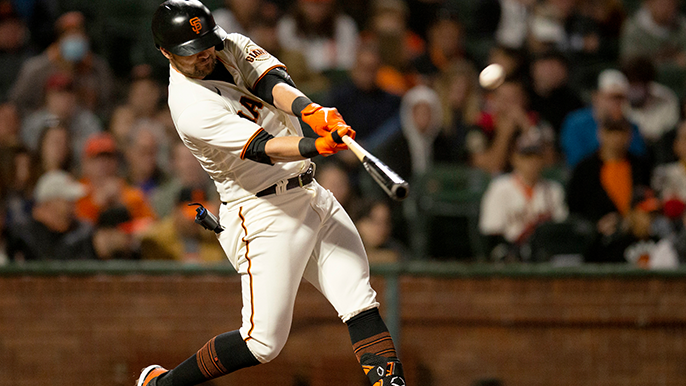
In 66 games with the Mets this season, J.D. Davis hit four home runs.
In 12 games with the Giants this season, J.D. Davis has hit four home runs.
Davis, who came over along with three prospects in the Darin Ruf trade, has provided a sudden jolt for San Francisco’s offense. Seven years younger and more defensively versatile than Ruf, he’s making the transaction look like a haul for the Giants.
“He’s got tremendous power,” Giants manager Gabe Kapler said after Wednesday’s 3-2 loss. “I think maybe it’s just finding his rhythm and his groove, being on time…He’s been swinging the bat really well. I think it might just be a comfort thing.”
The power surge comes from a combination of two factors, Davis theorizes: a fully healthy left hand and more regular playing time. Both contribute to that “comfort” Kapler referenced.
Davis underwent offseason surgery to repair a torn ligament in his left hand. Before the injury, grip tests showed his grip measured at 152 pound-force per square inch (PSI), he said. After the surgery, it was down to 91 PSI.
The infielder spent the first part of the season trying to get healthy and building back strengths. As the months went by, his grip trended up — 105, 117, 123, 130, he recalls.
About a week before the trade deadline, Davis said his hand started to feel really good. The last time he measured his grip strength, a day before he got traded, he tested to 141 PSI. He’s since scaled back on rehab and instead focuses more on activation and recovery.
“I’m not worrying about my hand,” Davis told KNBR. “When my hand is healthy, I can really dive into my mechanics. So like, manipulate the barrel. Kind of, say, be a little less conservative. I’m able to get my swing off. And then I’m able to take more swings in the cage. I’m able to feel 100% every single day.”
It turns out, hands are important for hitters. Davis’ left hand is the one on the bottom of the handle. Being able to fully grip it allows him to control the barrel much more precisely and gives his top hand — the power center — a chance.
“I think that has to be a big thing,” Davis said. “I think that helps me be able to move the bat, feel the bat more in my fingers. Because when your hand isn’t doing too well, you kind of have it stiff. Try to manipulate or just keep it strong so that way you can control the barrel. But with it now, my hand being healthy, I’m able to grip it a little more, able to catch the ball a little more out in front.”
Davis’ situation in San Francisco is also better than it was in New York, he said. He was in a similar platoon role with the Mets, but rarely — if ever — faced right-handed pitchers. He’d go “three, four days” without seeing a pitch, he said.
With the Giants, Davis has played essentially an everyday role, either at third base, designated hitter or coming off the bench. That’s been a boon for his rhythm.
“Pitchers are throwing the ball harder,” Davis said. “Balls are moving more. It’s very important for guys to train their eyes. Everyone thinks it’s all physical and everything. But when you don’t have the ability to see pitches and see shapes or see movements, your timing can get thrown off real quick.”
The results came almost immediately. In his second game as a Giant, Davis launched a two-run shot the other way off Clayton Kershaw. The homer was quite the introduction for Davis, as it’s rare for a right-handed hitter to scale the right-field arcade wall.
The very next game, Davis added another home run in Oakland on Aug. 6. Easy, dead-center pop.
A home run “drought” lasted three more games before Davis drilled a homer off Padres lefty Sean Manaea with an exit velocity of 106.7 mph.
Then on Wednesday, Davis’ solo home run off Diamondbacks reliever Chris Devenski jumped off his bat at 104.1 mph and sailed 400 feet into the left field bleachers. And it wasn’t even Davis’ hardest hit ball of the night — he drilled a 107.5 mph shot deep into Triples Alley in the eighth, but Daulton Varsho robbed what would have been extra bases with a .070 catch probability web gem.
But the line out was still an example of Davis seeing the ball well, letting it travel into the zone and taking the SF coaching staff’s advice of using the middle of the field and using his legs.
He finished the game 2-for-3 with a walk, improving his slash line as a Giant to .364/.447/.758.
It’s far too premature to fully evaluate the Davis trade, but the early returns are notable. No other player that switched teams at the deadline has hit more home runs than Davis.
Ruf hasn’t left the yard yet for New York. Neither has Whit Merrifield in Toronto. Juan Soto has hit one for the Padres (while providing an elite .947 OPS). Brandon Drury, also for San Diego, has three. So does new Dodger Joey Gallo, Red Sox leadoff man Tommy Pham and former Oriole Trey Mancini.
Though Davis’ stats are unsustainable long term, he’s proving that sometimes the most impactful trades don’t have to be blockbusters.
“It’s all just kind of coming together right now,” Davis said.

